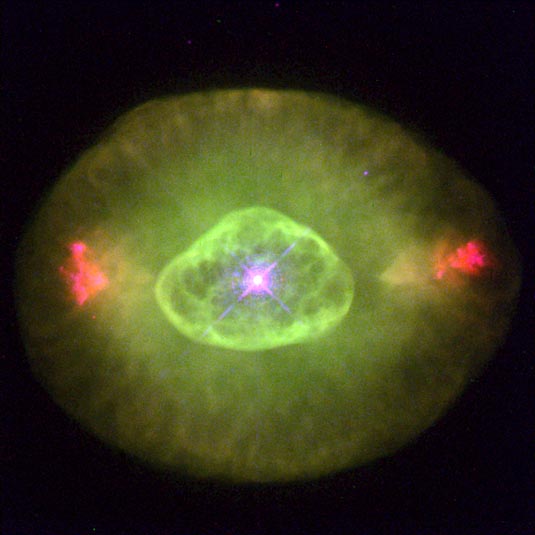
Planetary nebula
RA 19h 44m 48.2s Dec +50° 31' 30.3"
Cygnus
Estimated 2000 to 5200 light years
8.8
27"× 24"
0.44 x 0.40 light years
NASA, Bruce Balick (U of Washington), Jason Alexander (U of Washington), Arsen Hajian (U.S. Naval Observatory), Yervant Terzian (Cornell University), Mario Perinotto (U of Florence, Italy), Patrizio Patriarchi (Arcetri Observatory, Italy)
December 17, 1997
ABOUT THIS IMAGE:
NGC 6826's eye-like appearance is marred by two sets of blood-red "fliers" that lie horizontally across the image. The surrounding faint green "white" of the eye is believed to be gas that made up almost half of the star's mass for most of its life. The hot remnant star (in the center of the green oval) drives a fast wind into older material, forming a hot interior bubble which pushes the older gas ahead of it to form a bright rim. (The star is one of the brightest stars in any planetary.) NGC 6826 is 2,200 light- years away in the constellation Cygnus. The Hubble telescope observation was taken Jan. 27, 1996 with the Wide Field and Planetary Camera 2.
From Wikipedia
NGC
6826 (also known as Caldwell 15) is a planetary nebula located in the
constellation Cygnus. It is commonly referred to as the "blinking
planetary", although many other nebulae exhibit such "blinking".
When viewed through a small telescope, the brightness of the central star
overwhelms the eye when viewed directly, obscuring the surrounding nebula.
However, it can be viewed well in the peripheral vision (averted vision),
which causes it to "blink" in and out of view as the observer's
eye wanders.
A distinctive feature of this nebula are the two bright patches on either
side, which are known as FLIERs, or Fast Low-Ionization Emission Regions.
They appear to be relatively young, moving outwards at supersonic speeds.
According to Bruce Balick (University of Washington), "some of their
observed characteristics suggest that they are like sparks flung outward
from the central star late in the very recent past (a thousand years ago).
Yet their shapes ... seem to suggest that they are stationary, and that
material ejected from the star flows past them, scraping gas from their
surfaces. Future Hubble observations will monitor any changes in the positions
of FLIERs to resolve this issue. In either case, the formation of FLIERs
cannot be easily explained by any models of stellar evolution."